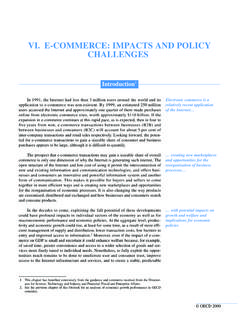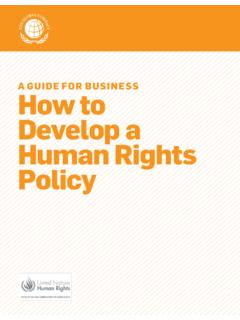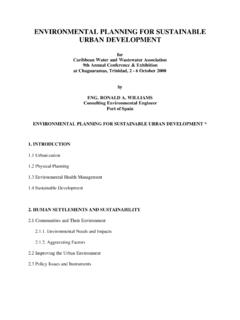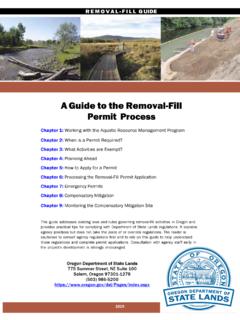Transcription of An Assessment of the Impacts of Climate Change on the ...
1 An Assessment of the Impacts of Climate Change on the Great Lakes by Scientists and Experts from Universities and Institutions in the Great Lakes Region The Environmental Law & Policy Center, in concert with the Chicago Council on Global Affairs, commissioned the following scientists and experts to produce this report pro bono to educate policymakers and the public about the significant changes affecting the Great Lakes, and the vital importance of taking actions now to protect our natural resources. Donald Wuebbles, University of Illinois Bradley Cardinale, University of Michigan Keith Cherkauer, Purdue University Robin Davidson-Arnott, University of Guelph, Ontaria, Canada Jessica Hellmann, University of Minnesota Dana Infante, Michigan State University Lucinda Johnson, University of Minnesota, Duluth Rob de Lo , University of Waterloo, Ontario, Canada Brent Lofgren, NOAA GLERL.
2 Aaron Packman, Northwestern University Frank Seglenieks, Environment and Climate Change Canada Ashish Sharma, University of Notre Dame and University of Illinois at Urbana-Champaign Brent Sohngen, The Ohio State University Michael Tiboris, Chicago Council on Global Affairs Daniel Vimont, University of Wisconsin, Madison Robyn Wilson, The Ohio State University Kenneth Kunkel, North Carolina State University and NOAA CICS-NC. Andrew Ballinger, North Carolina State University and NOAA CICS-NC. Table of Contents Executive 1. Importance of the Great Climate Change : From global to the Great Lakes Potential risks and vulnerabilities for the Great Public perception of the Great Lakes: Value and 2.
3 Regional Climate Change in the Great Air temperature changes and Precipitation Extreme Cold-season processes (snow and ice)..14. 3. Changes in the Great Changes in lake temperature and Great Lakes ice cover Hydrologic Changes in lake 4. Changes in Great Lakes watershed Climate Change effects on lake Land use / land cover Agricultural watersheds and agricultural Urban watersheds and urban Impacts on the Great Water quality Impacts on the Great 5. Impacts on lake Mixing and Biodiversity and invasive Nutrient loading and algal Coastal Coastal 6. Public and economic Impacts of changes to the Great Water Public Impacts on Indigenous People in the Great Lakes Industrial needs for 7.
4 Conclusions ..48. Executive Summary Introduction of migratory birds and waterfowl. More than 3,500 species Climate Change is causing significant and far-reaching of plants and animals use its large network of streams, Impacts on the Great Lakes and the Great Lakes region. lakes, inland wetlands, coastal marshes and forests. Many In recent years, our planet has experienced some of the of these species are rare or are found nowhere else. warmest temperatures ever recorded, record-breaking weather extremes, powerful storms, increasing tragic The Great Lakes are large enough to themselves influence flooding from rising sea levels and associated storm surge, weather in the region.
5 The Lakes moderate temperatures huge wildfires, and continued melting of glaciers and polar throughout the year, helping to cool nearby lands in the sea ice. The accelerating pattern of changes in the Earth's summer and warm them in winter. Their humidity feeds Climate is affecting the Great Lakes. Here, we draw on the cloud cover and precipitation both over the lakes and array of existing research to assess how the shifting global downwind. That causes both lake effect snowstorms, Climate Impacts the unique Great Lakes region. and summer rainfall that provides ideal growing conditions for orchards in Michigan's fruit belt.. The Great Lakes have an enormous impact , seen and unseen, on the 34+ million people who live within its Basin.
6 These Climate Change presents challenges to the Great Lakes, millions of people rely on the freshwater lakes for drinking with complicated effects and inter-relationships. water, fisheries, recreation, and commerce and industry. The Great Lakes contain 5,500 cubic miles of freshwater, Air Temperature Increases one of the very largest freshwater resources in the world. The Great Lakes region has tracked global increases in The Great Lakes support one of the world's largest regional temperature and outpaced trends in some parts of the economies similar to those of whole developed nations. contiguous United States. Between 1901-1960 and 1985- Agriculture, industrial manufacturing, fishing, and recreation 2016, the Great Lakes basin has warmed F in annual together form an economic engine.
7 Regional fisheries alone mean temperature, exceeding average changes of F for represent a $7 billion per year industry. Tourism generates the rest of the contiguous United States. By the end of the $16 billion more. 21st century, global average temperatures are expected to rise an additional F to F, depending on future Heavy human use over the past two centuries has taken its greenhouse gas emissions, with corresponding changes in toll in the forms of habitat loss and fragmentation, influxes of the Great Lakes region. invasive species, and polluted air, water, and sediments. Soil and nutrient runoff from agricultural fields and concentrated Heavy Precipitation and Flooding animal feedlot operations (CAFOs) imperil water quality and A warmer atmosphere holds more moisture, increasing wildlife populations in many parts of the basin, threatening the frequency and intensity of heavy rain and snow public and wildlife health and the economic vitality of the events.
8 Overall annual precipitation increased 4%. region. Climatic changes now underway further stress these between 1901 and 2015, but the Great Lakes region saw ecosystems, alternatively raising and lowering lake levels an almost 10% increase over this interval with more of and threatening the region in new ways. this precipitation coming as unusually large events. In the future, precipitation will likely redistribute across the The Great Lakes sustain remarkable populations of fish and seasons. We expect wetter winters and springs, while habitats for wildlife. More than 170 species of fish live in summer precipitation should decrease by 5-15% for most the lakes, streams, rivers, and connecting waterways.
9 Trout, of Great Lake states by 2100. sturgeon, walleye, lake whitefish and other varieties of fish are once again becoming plentiful among the five Great These increases in precipitation will likely increase flooding Lakes. The basin's ecosystems support wolves and moose across the Great Lakes region. In cities with abundant roofs, while providing resting and breeding grounds for large flocks concrete, and other impermeable surfaces, this will likely 1. damage homes, roadways, and other infrastructure. In rural areas, intense rains and melting snows will increase runoff Yet, even with increased water management in agricultural and erode soils. In rural areas, increased flooding will also watersheds, Climate Change will likely reduce crop yields cause soil erosion.
10 In combination with more unpredictable for both soybean and maize by 10% - 30% by mid-century in precipitation and warmer temperatures, these effects could the southern parts of the Great Lakes watershed. Soybean seriously curtail Midwestern agricultural production. and maize production will likely move northward. Extreme Weather Urban Issues Climate Change is causing more extreme weather across In the summer, high temperatures and heat waves cause the United States. Heat waves have become more common poorer air quality, which harms public health, especially since the 1960s while extreme cold temperatures have for the most vulnerable people the elderly and children generally decreased.






